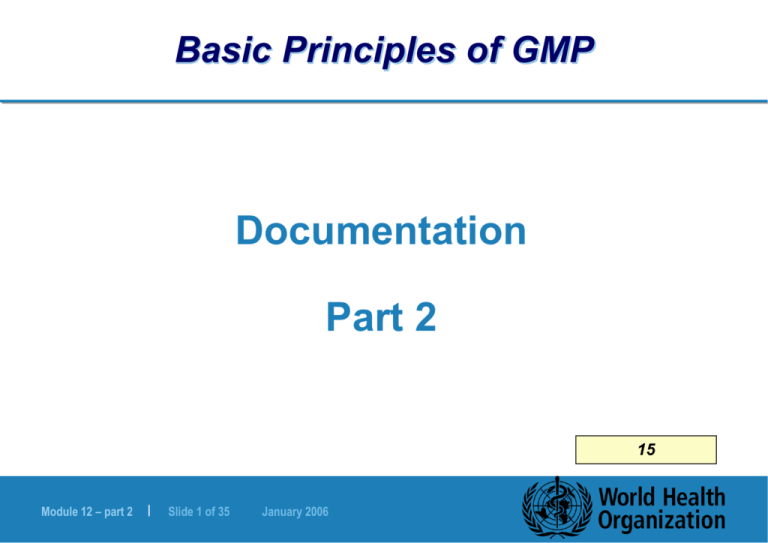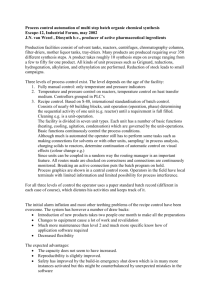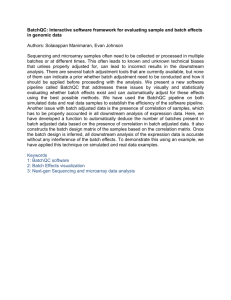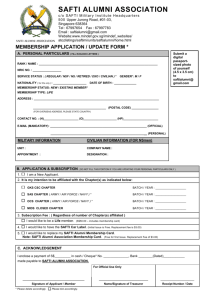Basic Principles of GMP
advertisement

Basic Principles of GMP Documentation Part 2 15 Module 12 – part 2 | Slide 1 of 35 January 2006 Documentation Labels What must be labelled? Containers, equipment, premises Label information? Clear, unambiguous, company format Intermediates and bulk products Colours can be used, e.g. green (accepted), red (rejected) 15.10 Module 12 – part 2 | Slide 2 of 35 January 2006 Basic Principles of GMP Different types of labels, e.g. cleaning status, production stage, status of materials Other types of labels? Module 12 – part 2 | Slide 3 of 35 January 2006 Basic Principles of GMP Labels can indicate the status of materials such as "quarantine" Module 12 – part 2 | Slide 4 of 35 January 2006 Documentation Finished Product Label National legislation, but includes: Name Active ingredients and amounts Batch number Expiry date Storage conditions, precautions if necessary Directions for use, earnings Name and address of manufacturer Module 12 – part 2 | Slide 5 of 35 January 2006 15.11 Documentation Reference standards Label to include: Name Potency or concentration Date of manufacture Expiry date Date the closure is first opened Storage condition Control number Module 12 – part 2 | Slide 6 of 35 15.12 January 2006 Documentation Specifications Specifications: Authorized, approved, signed and dated Starting, packaging materials and finished products: include tests on identity, content, purity, quality Intermediates and bulk Water, solvents and reagents QC, QA or documentation centre 15.14, 15.15 Module 12 – part 2 | Slide 7 of 35 January 2006 Documentation Specifications and Test Procedures Specifications: Periodic review Compliance with current pharmacopoeia Pharmacopoeia, reference standards and spectra available Test Procedures: Validated (facility and equipment) before routinely used 15.13, 15.16 -15.17 Module 12 – part 2 | Slide 8 of 35 January 2006 Documentation Specifications: Starting and packaging materials Include: Name (e.g. INN) and internal code Pharmacopoeia (if applicable) Qualitative and quantitative requirements and limits Other data may include: Supplier Sampling procedure or reference Storage conditions, precautions Retest date Module 12 – part 2 | Slide 9 of 35 15.18 -15.19 January 2006 Basic Principles of GMP What types of documents are associated with sampling of starting materials? Module 12 – part 2 | Slide 10 of 35 January 2006 Documentation Specifications: Finished products Include: Name and code reference Names of actives (e.g. INN) Formula Dosage form, package details Reference to sampling Qualitative and quantitative requirements and limits Storage conditions and precautions Shelf life Module 12 – part 2 | Slide 11 of 35 15.21 January 2006 Documentation Master Formulae - I Master formula for each product and batch size Manufacturing instructions include: Name of product with product reference code Dosage form, strength and batch size List of starting materials including quantities and unique reference code Expected final yield with acceptable limits (and intermediate yields) Processing location and principal equipment 15.22 – 15.23 Module 12 – part 2 | Slide 12 of 35 January 2006 Documentation Master Formulae - II Manufacturing instructions - continued Equipment preparation (e.g. cleaning, assembling, calibrating, etc.) Detailed stepwise processing instructions and checks, pre-treatments, sequence of additions, times, temperatures, etc. In-process control instructions and their limits Storage requirements and special precautions Any special precautions if needed Module 12 – part 2 | Slide 13 of 35 January 2006 15.22 – 15.23 Documentation Master Formulae - III Authorized packing instructions for each product, pack size and type, and to include: Name of the product Dosage form, strength and method of application Pack size (number, weight or volume of product in final container) List of all packaging materials (quantities, size, types and code number) 15.24 Module 12 – part 2 | Slide 14 of 35 January 2006 Documentation Master Formulae – IV Packing instructions - continued Examples of printed packaging materials, with location of batching information Special precautions, including area clearance checks (before and after operations) Description of the packaging operation including equipment to be used In-process controls, with sampling instructions and acceptance limits 15.24 Module 12 – part 2 | Slide 15 of 35 January 2006 Documentation Module 12 – part 2 | Slide 16 of 35 January 2006 Documentation Batch Processing Record – I Record kept for each batch processed Based on the master or specifications (e.g. copied to avoid errors) Check suitability of area and equipment clear of previous products, documents, materials Checks recorded 15.25 – 15.26 Module 12 – part 2 | Slide 17 of 35 January 2006 Documentation Batch Processing Records – II Information recorded during processing include: Name of the product, batch number Dates and times (e.g. start, major steps, completion) Name of person responsible for each stage of production Name of operators carrying out each step (check signatures) Theoretical quantities for materials in the batch Reference number and quantity of materials used in the batch 15.27 Module 12 – part 2 | Slide 18 of 35 January 2006 Documentation Batch Processing Records – III Main processing steps and key equipment In-process controls carried out, person's initials, and results obtained Yield at each stage with comments on deviations Expected final yield with acceptable limits Comments on any deviations from process Area clearance check, instructions to operators Record of activities 15.27 Module 12 – part 2 | Slide 19 of 35 January 2006 Documentation Module 12 – part 2 | Slide 20 of 35 January 2006 Documentation Batch Packaging Records – I For every batch or part of a batch Based on approved packaging instructions, copied or computer generated Before start – checks that equipment and work station suitable and clean, no previous product Line clearance (opening) Recorded 15.28, 15.29 Module 12 – part 2 | Slide 21 of 35 January 2006 Documentation Batch Packaging Records – II Name of the product, batch number and quantity to be packed Batch number, theoretical quantity and actual quantity of finished product Actual quantity obtained – reconciliation Dates and times of operation Name of person responsible for packaging, initials of operators carrying out each step Checks, and in-process results 15.30 Module 12 – part 2 | Slide 22 of 35 January 2006 Documentation Batch Packaging Records – III Details of packaging operation, including equipment and line used Returns to store Specimen of printed packaging materials, with batch coding approval (batch number and expiry date) Comments on deviations from the process and actions taken and authorization Reconciliation of packaging materials, including issues, use, returns and destruction 15.30 Module 12 – part 2 | Slide 23 of 35 January 2006 Documentation Module 12 – part 2 | Slide 24 of 35 January 2006 Documentation Standard Operating Procedures (SOP) - I What is an SOP? Who is responsible for preparing SOPs? What is the format for an SOP? Which activities require SOPs? Where should SOPs be stored? Are SOPs associated with records? 15.31 Module 12 – part 2 | Slide 25 of 35 January 2006 Documentation Module 12 – part 2 | Slide 26 of 35 January 2006 Documentation Standard Operating Procedures - II Which activities require SOPs? Equipment and analytical apparatus: – Assembly, validation – Calibration – Internal labelling, quarantine and storage of materials – Operation – Maintenance and cleaning Personnel matters: • Qualification • Training • Clothing 15.31 • Hygiene Module 12 – part 2 | Slide 27 of 35 January 2006 Documentation Standard Operating Procedures - III Which activities require SOPs? Environmental monitoring Pest control Complaints Recalls Returned goods 15.31 Module 12 – part 2 | Slide 28 of 35 January 2006 Documentation Standard Operating Procedures - IV SOP and records for receiving materials Name of material as on delivery note Name and in-house code Date of receipt Supplier's and manufacturer's name Batch number Quantity and number of containers received State of container and other information 15.33 Module 12 – part 2 | Slide 29 of 35 January 2006 Documentation Standard Operating Procedures - V Other SOPs include: Internal labelling, quarantine and storage of materials Operation, maintenance, calibration and cleaning of all instruments and equipment – production and QC Sampling of materials Batch numbering systems Material testing at all stages of production Complaints, recalls 15.31, 15.32 Module 12 – part 2 | Slide 30 of 35 January 2006 Documentation Standard Operating Procedures - VI Which activities require SOPs? (Continued) Batch release or rejection Maintenance of distribution records Equipment assembly and validation Maintenance, cleaning and sanitation Personnel recruitment, training, clothing and hygiene Environmental monitoring Pest control …and many more… Module 12 – part 2 | Slide 31 of 35 January 2006 15.31 Documentation Stock Control and Distribution Records What should be recorded? Where should records be stored? Why are the records important? Module 12 – part 2 | Slide 32 of 35 January 2006 Documentation Group Session II From your own experience of factory inspections, how do documentation systems in this country compare with the WHO model? Identify gaps and reasons What will help and/or hinder the process of eliminating these gaps? Module 12 – part 2 | Slide 35 of 35 January 2006







